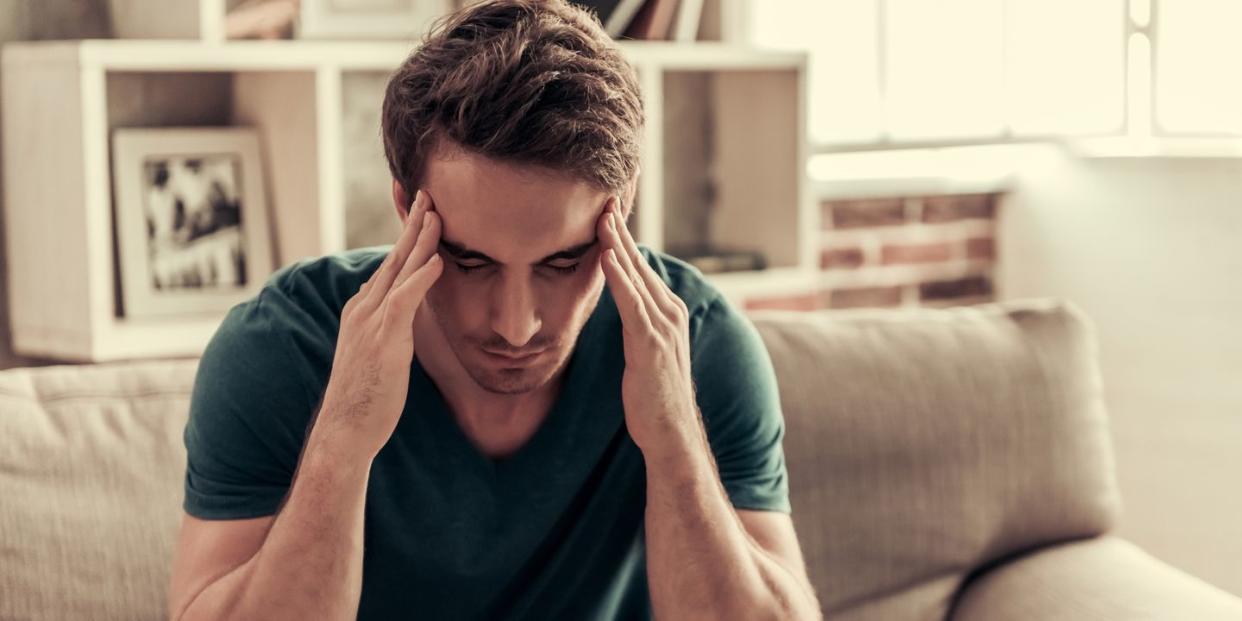13 Types of Headaches and How to Treat Them

Headaches are a headache, if not a total overtake-and-really-mess-up-your-day or -life kind of issue. Sometimes headaches can be quickly remedied with over-the-counter meds, while other times they may be a sign of something more serious and require medical attention.
A headache isn’t just a headache. They typically fall into one of two categories: primary and secondary headaches. Why it’s good to know this: Knowing which category it falls in, and knowing which specific type of headache it is, can help you figure out how to treat it best.
Here’s what signs and symptoms to look for to figure out what type of headaches you have.
Primary Headaches
According to Huma Sheikh, MD, headache specialist and board certified neurologist in New York City, primary headache disorders describes headaches that are the result of pain within your head. These include tension headaches, cluster headaches, migraine, hemicrania continua, and ice pick headaches (as bad as they sound).
Tension headache
Tension headaches are the most common type of headache, says Sarah Ling, DO, a family medicine physician in Waukee, Iowa. They typically involve pain on both sides of the head at the same time (bilateral distribution), are mild to moderate in intensity, and are quickly treatable.
“Stress, mental, and physical tension are the most common causes of this type of headache,” she says. “Preventive treatment is important if this type of headache happens frequently (10 or more headaches per month).”
Acute treatment options include nonsteroidal anti-inflammatory drugs (NSAIDs), manual therapy (osteopathic manual treatment, massage, chiropractic treatment and acupuncture). Manual therapies may also be part of a longer-term treatment program. Longer term treatments include medications such as tricyclic antidepressants (TCAs) and SSRIs, she says.
Migraine
According to Dr. Ling, migraines often hit people in their 30s to 40s and tend to occur on one side of the head. They can be triggered by many things, including stress, weather changes, and sleep disturbances.
“Typically, migraines tend to feel like throbbing,” she explains. Sometimes it feels like there’s a drum beating in your head. Migraines may be accompanied by nausea, vomiting, and sensitivity to light or sound.
Treatments for migraines work best if you administer them when you feel the first symptoms, as opposed to waiting it out for a while.
If you have migraines, it’s good to see a doctor to figure out how to control them. They can prescribe migraine-specific medications called triptans. They may also recommend that you take anti-nausea medications.
If you get migraines, you already know that you’ll want to take steps to keep them from recurring. There are medications for that. Calcitonin gene-related peptide (CGRP) antagonists are available to prevent headaches that occur for more than half of a month, Dr. Ling says. Other general preventive measures include exercising, cognitive-behavioral therapy, counseling, and electrical nerve stimulation.
“Migraine is much more common in women but when they occur in men, they can be much harder to treat,” Dr. Sheikh adds. “Migraine affects about 26 million people in the U.S., [with about one-fourth being men.”
Cluster headache
Cluster headaches are typically very identifiable, Dr. Ling says. They commonly affect men more than women and are associated with some factors you can control, such as tobacco smoking, and others you can’t, including genetics (runs in families), and head trauma (preventable in some cases, but not always).
You will likely know if you are experiencing a cluster headache, as symptoms include an attack on one side of the head (pain of the eye, above the eye, or close to the temple), often described as ‘stabbing,’” Dr. Ling explains. “Occasionally, on the same side as the headache, you will experience eye drainage, a red eye, and a runny nose.”
If you’re having a cluster headache attack, acute treatment includes oxygen or triptans, Dr. Ling says. Cluster headaches can be recurrent, and to prevent these recurrent attacks, you may need to take a drug to relax blood vessels (such as Verapamil), or you may benefit from a short course of corticosteroids. If you have these, you’re going to want to see a medical professional to figure out what is triggering them and which treatments will work best for you.
Hemicrania continua
This is a much less common type of headache in which a person has continuous pain on one side of their head, usually behind the eye and in the temple area, Dr. Sheikh explains. “Continuous” meaning that hemicrania continua sometimes goes on for months. An NSAID that is preferred for treatment of this type of headache is called Indomethacin.
Ice pick headache
An ice pick headache gets its name from the fact that it involves short, stabbing pains that last for a few seconds, according to the Cleveland Clinic. They can occur multiple times per day and come on without warning. While they can occur in different parts of your head, if you’re experiencing ice pick headaches regularly in the same spot, you should talk to your doctor, as other brain conditions may cause a similar pain.

Secondary Headaches
Secondary headaches are usually brought on by something else that’s going on; it doesn’t start with something happening in your head. Other forces that can result in headaches include everything from taking in too much caffeine to not having blood pressure well controlled. Once you figure out what the outside source is, you can typically take steps to manage that and lessen the frequency of the headache it’s causing.
Sinus headache
Unsurprisingly, sinus headaches often happen after you have a cold or other upper respiratory infection, according to the Mayo Clinic. They tend to feel concentrated in the sinus area, under the eyes, and behind the nose. The tricky thing is that migraines can cause pain there, too, and sometimes it’s hard to know the difference between them. One telltale sign is that sinus headaches don’t usually include nausea or vomiting. If you get “sinus headaches” frequently, see a doc to make sure it’s not a migraine. This way, you’ll get a treatment that actually helps keep pain away or ease it quickly when it comes up.
Rebound headache
Rebound headaches can occur when someone takes pain medications in excess to treat their headache. Caffeine-containing medications are especially known to be associated with these. Rebound headaches can feel mild and tension-type, or they can feel as painful as migraines.These are sometimes called “medication overuse headaches,” explains Dr. Sheikh. You’ll want to talk with a doctor to figure out how to break the pain-painkiller-pain cycle.
Hypertensive headache
This type of headache occurs due to excessively high blood pressure, Dr. Sheikh says. If someone has undiagnosed high blood pressure or it goes up abruptly, it can cause this type of headache. Get medical attention immediately if you have a headache along with changes in vision, numbness, nosebleeds, chest pain, or shortness of breath.
Post-traumatic headache
This type of headache occurs when someone has a concussion, which can be mild to severe. “The concussion can be due to a number of different reasons and can cause a number of different symptoms, including trouble sleeping, mood disorders, as well as trouble concentrating as well as headache,” Dr. Sheikh says. “It can [possibly be felt] on both sides or one side and can feel like a tension headache or migraine.” (See the latest on concussion treatments here.)
Thunderclap headache
Thunderclap is a descriptive term for a type of headache that comes on suddenly and becomes most severe over a few seconds or minutes, Dr. Sheikh says.
“A headache with this character can occur with some secondary headaches like a stroke or hemorrhage in the brain, as well as an aneurysm rupture,” she says. “A headache with a thunderclap quality needs to be worked up immediately in the ER, since they can be due to dangerous causes like bleeding in the brain.”
Caffeine headache
Caffeine headaches can come on when you’re had too much caffeine, or when you’ve decided to quit caffeine cold turkey. If you experience migraines, you’re also more likely to experience caffeine headaches, as the stuff that gives you a jolt affects blood flow to the brain, according to the American Migraine Foundation. Use this guide to help yourself cut down on caffeine in the most painless ways possible.
Exertion headache
An exertion headache typically occurs after participating in intense physical activity, such as strength or cardiovascular exercise, or even after having sex, according to the Cleveland Clinic. These headaches are thought to be due to increased blood flow to the skull, leading to throbbing pain on both sides of the head. These headaches don’t tend to last longer than a few hours; sometimes they resolve in minutes.
You Might Also Like

